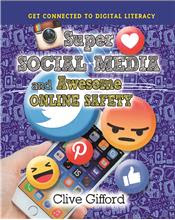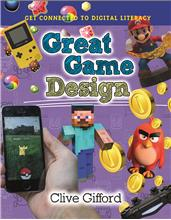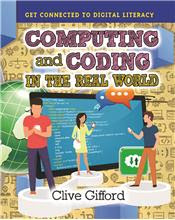| ________________
CM . . . . Volume XXIV Number 30. . . .April 6, 2018
excerpt:
There are four books in Clive Gifford’s “Get Connected to Digital Literacy” series, Super Social Media and Awesome Online Safety, Great Game Design, Web Page Design, and Computing and Coding in the Real World. Each title contains similar elements and provides an overview of the topic. The start of each book contains a general introduction that allows readers with varying degrees of experience to understand the topic. Readers from absolute beginners to those with more experience will have something that they can take away from the text. Following an introduction, each book then breaks down key elements important to understanding the chosen topic. The books each contain a table of contents, glossary, great factoids, additional resources and an index. The terminology and keywords chosen to explain the concepts are explained in simple layperson terms. The depth of the concepts explored in each text is enough to give readers a general sense of understanding. For more in-depth reading and exploration, the reader will need to find resources that address each concept more thoroughly. Use of these texts for media literacy helps to decode these mediums from a black box into smaller, more easily understood parts. The images and layout of the books encourage readers to quickly engage and flip through the books as they search for specific ideas that interest them. No page is dense enough to lose the reader’s interest as information is condensed into small digestible points. Coloured headings, images and text make for a visually engaging text. The reading level is for junior grades (4-6), and all jargon is broken down through an explanation with supporting images. Super Social Media and Awesome Online Safety breaks down the way social media apps and sites are created and consumed. The book goes through historical social applications and interactions and demonstrates how they have morphed into today’s media. This title’s greatest strength is explaining the way information is spread and how the business of social media affects the medium itself. The language and voice of this text is clearly from the perspective of an adult sharing the history and key terms with the reader. Some current popular social media sites are listed and their purposes explained. The current examples of popular apps and sites may need an addendum as these may be replaced by newer examples quickly. Driving question: What is social media? Great Game Design breaks down different games into their most basic elements. By understanding the requisite parts of games, the book links some popular games to illustrate the basic gaming elements. However, this is not a book about creating games, gaming or gaming culture; it is a book that explains gaming as a medium for consumption A parallel text to understand this book is to ask what makes a great television show. It provides enough information about many different types of games from MMORPG to shooters to casual games so that anyone unfamiliar with gaming could get a basic grasp. Driving question: What are the parts of a video game? Web Page Design includes a short history of the internet and the background of how the web works. It thoughtfully explains the parts of the internet that many users completely take for granted. From understanding domains, cascading style sheets and content systems, this book serves as introductory crash course on the behind-the-scenes inner working of the internet via a web browser. The coding examples start to explain the building blocks of web sites. Unfortunately, the title is a bit misleading as there is less to do with web design but more of the history of the web. Understanding how hyperlinks (links) work, tagging images in HTML and coding an unordered lists are examples used that show just enough detail to demystify how they work their purpose. This book should not be used to learn web design but for researching how the web is accessed, its history and how browsers decode information from other computers. Driving question: How does the internet through a web browser work? Computing and Coding in the Real World explains computational thinking and computational ideas when used in everyday situations. There are no coding languages or programming examples here. The book uses examples from sensors, stock control and internet of things devices to illustrate how code is embedded into the usage and controls of these devices. The algorithms created to use these tools are not explained, but the very basic computational thinking required to explain their use is listed for each device or process. The book breaks down the problem set required to understand what the device or process has to do in order for it to be operational. If getting an understanding of the background processes of scanners, qr codes and simple robots are what you are searching for, this book gives you a very simple explanation on how that happens. Driving question: Where can I find algorithms in everyday items? Generally, this series is a great introduction to algorithms and their effect on the different media. Be clear that this does not teach you how to do any of the things that the titles allude to, but, instead demystify the processes, mediums and ideas behind them. Super Social Media and Awesome Online Safety - Highly Recommended. Francis Ngo is a teacher librarian at Forest Hill Junior and Senior Public School in Toronto, ON.
Next Review |
Table of Contents for This Issue
- April 6, 2018. |



